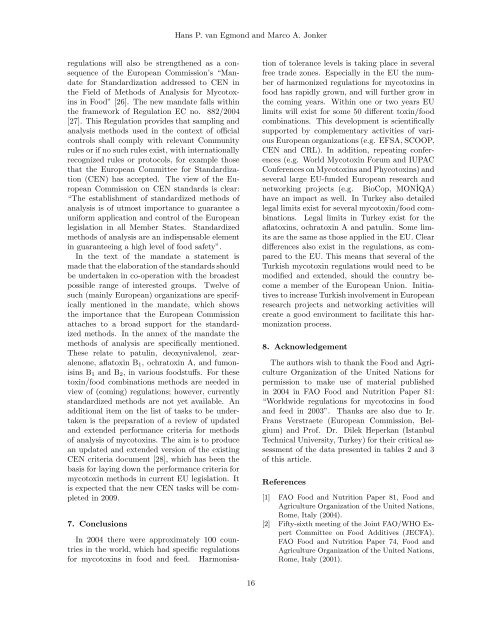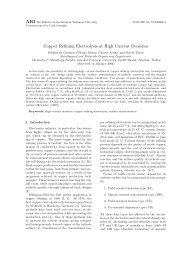Regulations for Mycotoxins in Food: Focus on the European ... - ARI
Regulations for Mycotoxins in Food: Focus on the European ... - ARI
Regulations for Mycotoxins in Food: Focus on the European ... - ARI
You also want an ePaper? Increase the reach of your titles
YUMPU automatically turns print PDFs into web optimized ePapers that Google loves.
egulati<strong>on</strong>s will also be streng<strong>the</strong>ned as a c<strong>on</strong>sequence<br />
of <strong>the</strong> <strong>European</strong> Commissi<strong>on</strong>’s “Mandate<br />
<str<strong>on</strong>g>for</str<strong>on</strong>g> Standardizati<strong>on</strong> addressed to CEN <str<strong>on</strong>g>in</str<strong>on</strong>g><br />
<strong>the</strong> Field of Methods of Analysis <str<strong>on</strong>g>for</str<strong>on</strong>g> <str<strong>on</strong>g>Mycotox<str<strong>on</strong>g>in</str<strong>on</strong>g>s</str<strong>on</strong>g><br />
<str<strong>on</strong>g>in</str<strong>on</strong>g> <str<strong>on</strong>g>Food</str<strong>on</strong>g>” [26]. The new mandate falls with<str<strong>on</strong>g>in</str<strong>on</strong>g><br />
<strong>the</strong> framework of Regulati<strong>on</strong> EC no. 882/2004<br />
[27]. This Regulati<strong>on</strong> provides that sampl<str<strong>on</strong>g>in</str<strong>on</strong>g>g and<br />
analysis methods used <str<strong>on</strong>g>in</str<strong>on</strong>g> <strong>the</strong> c<strong>on</strong>text of official<br />
c<strong>on</strong>trols shall comply with relevant Community<br />
rules or if no such rules exist, with <str<strong>on</strong>g>in</str<strong>on</strong>g>ternati<strong>on</strong>ally<br />
recognized rules or protocols, <str<strong>on</strong>g>for</str<strong>on</strong>g> example those<br />
that <strong>the</strong> <strong>European</strong> Committee <str<strong>on</strong>g>for</str<strong>on</strong>g> Standardizati<strong>on</strong><br />
(CEN) has accepted. The view of <strong>the</strong> <strong>European</strong><br />
Commissi<strong>on</strong> <strong>on</strong> CEN standards is clear:<br />
“The establishment of standardized methods of<br />
analysis is of utmost importance to guarantee a<br />
uni<str<strong>on</strong>g>for</str<strong>on</strong>g>m applicati<strong>on</strong> and c<strong>on</strong>trol of <strong>the</strong> <strong>European</strong><br />
legislati<strong>on</strong> <str<strong>on</strong>g>in</str<strong>on</strong>g> all Member States. Standardized<br />
methods of analysis are an <str<strong>on</strong>g>in</str<strong>on</strong>g>dispensable element<br />
<str<strong>on</strong>g>in</str<strong>on</strong>g> guarantee<str<strong>on</strong>g>in</str<strong>on</strong>g>g a high level of food safety”.<br />
In <strong>the</strong> text of <strong>the</strong> mandate a statement is<br />
made that <strong>the</strong> elaborati<strong>on</strong> of <strong>the</strong> standards should<br />
be undertaken <str<strong>on</strong>g>in</str<strong>on</strong>g> co-operati<strong>on</strong> with <strong>the</strong> broadest<br />
possible range of <str<strong>on</strong>g>in</str<strong>on</strong>g>terested groups. Twelve of<br />
such (ma<str<strong>on</strong>g>in</str<strong>on</strong>g>ly <strong>European</strong>) organizati<strong>on</strong>s are specifically<br />
menti<strong>on</strong>ed <str<strong>on</strong>g>in</str<strong>on</strong>g> <strong>the</strong> mandate, which shows<br />
<strong>the</strong> importance that <strong>the</strong> <strong>European</strong> Commissi<strong>on</strong><br />
attaches to a broad support <str<strong>on</strong>g>for</str<strong>on</strong>g> <strong>the</strong> standardized<br />
methods. In <strong>the</strong> annex of <strong>the</strong> mandate <strong>the</strong><br />
methods of analysis are specifically menti<strong>on</strong>ed.<br />
These relate to patul<str<strong>on</strong>g>in</str<strong>on</strong>g>, deoxynivalenol, zearalen<strong>on</strong>e,<br />
aflatox<str<strong>on</strong>g>in</str<strong>on</strong>g> B1, ochratox<str<strong>on</strong>g>in</str<strong>on</strong>g> A, and fum<strong>on</strong>is<str<strong>on</strong>g>in</str<strong>on</strong>g>s<br />
B1 and B2, <str<strong>on</strong>g>in</str<strong>on</strong>g> various foodstuffs. For <strong>the</strong>se<br />
tox<str<strong>on</strong>g>in</str<strong>on</strong>g>/food comb<str<strong>on</strong>g>in</str<strong>on</strong>g>ati<strong>on</strong>s methods are needed <str<strong>on</strong>g>in</str<strong>on</strong>g><br />
view of (com<str<strong>on</strong>g>in</str<strong>on</strong>g>g) regulati<strong>on</strong>s; however, currently<br />
standardized methods are not yet available. An<br />
additi<strong>on</strong>al item <strong>on</strong> <strong>the</strong> list of tasks to be undertaken<br />
is <strong>the</strong> preparati<strong>on</strong> of a review of updated<br />
and extended per<str<strong>on</strong>g>for</str<strong>on</strong>g>mance criteria <str<strong>on</strong>g>for</str<strong>on</strong>g> methods<br />
of analysis of mycotox<str<strong>on</strong>g>in</str<strong>on</strong>g>s. The aim is to produce<br />
an updated and extended versi<strong>on</strong> of <strong>the</strong> exist<str<strong>on</strong>g>in</str<strong>on</strong>g>g<br />
CEN criteria document [28], which has been <strong>the</strong><br />
basis <str<strong>on</strong>g>for</str<strong>on</strong>g> lay<str<strong>on</strong>g>in</str<strong>on</strong>g>g down <strong>the</strong> per<str<strong>on</strong>g>for</str<strong>on</strong>g>mance criteria <str<strong>on</strong>g>for</str<strong>on</strong>g><br />
mycotox<str<strong>on</strong>g>in</str<strong>on</strong>g> methods <str<strong>on</strong>g>in</str<strong>on</strong>g> current EU legislati<strong>on</strong>. It<br />
is expected that <strong>the</strong> new CEN tasks will be completed<br />
<str<strong>on</strong>g>in</str<strong>on</strong>g> 2009.<br />
7. C<strong>on</strong>clusi<strong>on</strong>s<br />
In 2004 <strong>the</strong>re were approximately 100 countries<br />
<str<strong>on</strong>g>in</str<strong>on</strong>g> <strong>the</strong> world, which had specific regulati<strong>on</strong>s<br />
<str<strong>on</strong>g>for</str<strong>on</strong>g> mycotox<str<strong>on</strong>g>in</str<strong>on</strong>g>s <str<strong>on</strong>g>in</str<strong>on</strong>g> food and feed. Harm<strong>on</strong>isa-<br />
Hans P. van Egm<strong>on</strong>d and Marco A. J<strong>on</strong>ker<br />
16<br />
ti<strong>on</strong> of tolerance levels is tak<str<strong>on</strong>g>in</str<strong>on</strong>g>g place <str<strong>on</strong>g>in</str<strong>on</strong>g> several<br />
free trade z<strong>on</strong>es. Especially <str<strong>on</strong>g>in</str<strong>on</strong>g> <strong>the</strong> EU <strong>the</strong> number<br />
of harm<strong>on</strong>ized regulati<strong>on</strong>s <str<strong>on</strong>g>for</str<strong>on</strong>g> mycotox<str<strong>on</strong>g>in</str<strong>on</strong>g>s <str<strong>on</strong>g>in</str<strong>on</strong>g><br />
food has rapidly grown, and will fur<strong>the</strong>r grow <str<strong>on</strong>g>in</str<strong>on</strong>g><br />
<strong>the</strong> com<str<strong>on</strong>g>in</str<strong>on</strong>g>g years. With<str<strong>on</strong>g>in</str<strong>on</strong>g> <strong>on</strong>e or two years EU<br />
limits will exist <str<strong>on</strong>g>for</str<strong>on</strong>g> some 50 different tox<str<strong>on</strong>g>in</str<strong>on</strong>g>/food<br />
comb<str<strong>on</strong>g>in</str<strong>on</strong>g>ati<strong>on</strong>s. This development is scientifically<br />
supported by complementary activities of various<br />
<strong>European</strong> organizati<strong>on</strong>s (e.g. EFSA, SCOOP,<br />
CEN and CRL). In additi<strong>on</strong>, repeat<str<strong>on</strong>g>in</str<strong>on</strong>g>g c<strong>on</strong>ferences<br />
(e.g. World Mycotox<str<strong>on</strong>g>in</str<strong>on</strong>g> Forum and IUPAC<br />
C<strong>on</strong>ferences <strong>on</strong> <str<strong>on</strong>g>Mycotox<str<strong>on</strong>g>in</str<strong>on</strong>g>s</str<strong>on</strong>g> and Phycotox<str<strong>on</strong>g>in</str<strong>on</strong>g>s) and<br />
several large EU-funded <strong>European</strong> research and<br />
network<str<strong>on</strong>g>in</str<strong>on</strong>g>g projects (e.g. BioCop, MON ˙ IQA)<br />
have an impact as well. In Turkey also detailed<br />
legal limits exist <str<strong>on</strong>g>for</str<strong>on</strong>g> several mycotox<str<strong>on</strong>g>in</str<strong>on</strong>g>/food comb<str<strong>on</strong>g>in</str<strong>on</strong>g>ati<strong>on</strong>s.<br />
Legal limits <str<strong>on</strong>g>in</str<strong>on</strong>g> Turkey exist <str<strong>on</strong>g>for</str<strong>on</strong>g> <strong>the</strong><br />
aflatox<str<strong>on</strong>g>in</str<strong>on</strong>g>s, ochratox<str<strong>on</strong>g>in</str<strong>on</strong>g> A and patul<str<strong>on</strong>g>in</str<strong>on</strong>g>. Some limits<br />
are <strong>the</strong> same as those applied <str<strong>on</strong>g>in</str<strong>on</strong>g> <strong>the</strong> EU. Clear<br />
differences also exist <str<strong>on</strong>g>in</str<strong>on</strong>g> <strong>the</strong> regulati<strong>on</strong>s, as compared<br />
to <strong>the</strong> EU. This means that several of <strong>the</strong><br />
Turkish mycotox<str<strong>on</strong>g>in</str<strong>on</strong>g> regulati<strong>on</strong>s would need to be<br />
modified and extended, should <strong>the</strong> country become<br />
a member of <strong>the</strong> <strong>European</strong> Uni<strong>on</strong>. Initiatives<br />
to <str<strong>on</strong>g>in</str<strong>on</strong>g>crease Turkish <str<strong>on</strong>g>in</str<strong>on</strong>g>volvement <str<strong>on</strong>g>in</str<strong>on</strong>g> <strong>European</strong><br />
research projects and network<str<strong>on</strong>g>in</str<strong>on</strong>g>g activities will<br />
create a good envir<strong>on</strong>ment to facilitate this harm<strong>on</strong>izati<strong>on</strong><br />
process.<br />
8. Acknowledgement<br />
The authors wish to thank <strong>the</strong> <str<strong>on</strong>g>Food</str<strong>on</strong>g> and Agriculture<br />
Organizati<strong>on</strong> of <strong>the</strong> United Nati<strong>on</strong>s <str<strong>on</strong>g>for</str<strong>on</strong>g><br />
permissi<strong>on</strong> to make use of material published<br />
<str<strong>on</strong>g>in</str<strong>on</strong>g> 2004 <str<strong>on</strong>g>in</str<strong>on</strong>g> FAO <str<strong>on</strong>g>Food</str<strong>on</strong>g> and Nutriti<strong>on</strong> Paper 81:<br />
“Worldwide regulati<strong>on</strong>s <str<strong>on</strong>g>for</str<strong>on</strong>g> mycotox<str<strong>on</strong>g>in</str<strong>on</strong>g>s <str<strong>on</strong>g>in</str<strong>on</strong>g> food<br />
and feed <str<strong>on</strong>g>in</str<strong>on</strong>g> 2003”. Thanks are also due to Ir.<br />
Frans Verstraete (<strong>European</strong> Commissi<strong>on</strong>, Belgium)<br />
and Prof. Dr. Dilek Heperkan (Istanbul<br />
Technical University, Turkey) <str<strong>on</strong>g>for</str<strong>on</strong>g> <strong>the</strong>ir critical assessment<br />
of <strong>the</strong> data presented <str<strong>on</strong>g>in</str<strong>on</strong>g> tables 2 and 3<br />
of this article.<br />
References<br />
[1] FAO <str<strong>on</strong>g>Food</str<strong>on</strong>g> and Nutriti<strong>on</strong> Paper 81, <str<strong>on</strong>g>Food</str<strong>on</strong>g> and<br />
Agriculture Organizati<strong>on</strong> of <strong>the</strong> United Nati<strong>on</strong>s,<br />
Rome, Italy (2004).<br />
[2] Fifty-sixth meet<str<strong>on</strong>g>in</str<strong>on</strong>g>g of <strong>the</strong> Jo<str<strong>on</strong>g>in</str<strong>on</strong>g>t FAO/WHO Expert<br />
Committee <strong>on</strong> <str<strong>on</strong>g>Food</str<strong>on</strong>g> Additives (JECFA).<br />
FAO <str<strong>on</strong>g>Food</str<strong>on</strong>g> and Nutriti<strong>on</strong> Paper 74, <str<strong>on</strong>g>Food</str<strong>on</strong>g> and<br />
Agriculture Organizati<strong>on</strong> of <strong>the</strong> United Nati<strong>on</strong>s,<br />
Rome, Italy (2001).



